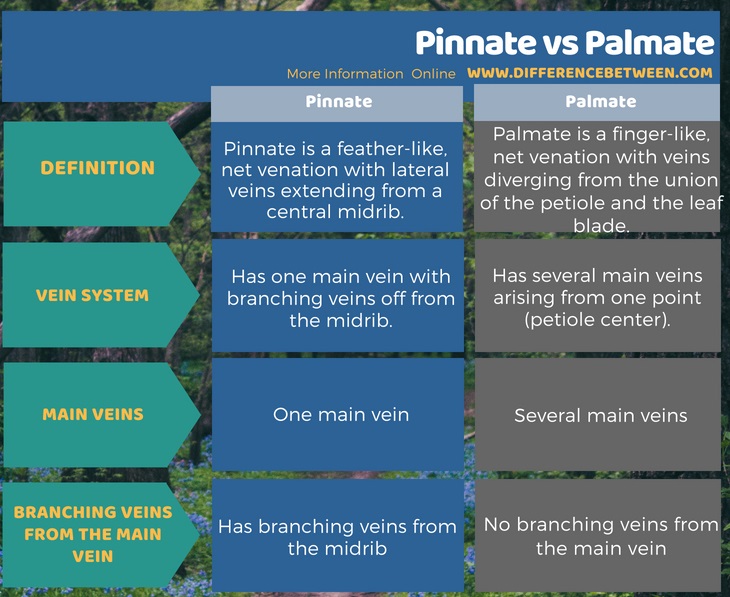Difference Between Pinnate and Palmate
Table of Contents
The key difference between pinnate and palmate is that the pinnate is the venation pattern in which one main vein extends from the base to the top of the leaf and smaller veins arise from the main vein whereas the palmate is the venation pattern in which several main veins radiate from one point where petiole and leaf blade unite.
Venation is an important characteristic of a leaf that can be used for identification of a plant. It is the arrangement of veins (primary, secondary and tertiary veins) in a leaf. The primary or main vein is the single middle prominent vein. The veins arising from the primary veins are the secondary veins. The primary veins are like a trunk of a tree while secondary veins are the branches of the same tree. The veins of a leaf can be arranged in different ways. Therefore, parallel, pinnate and palmate are these three types.
CONTENTS
1. Overview and Key Difference
2. What is Pinnate
3. What is Palmate
4. Similarities Between Pinnate and Palmate
5. Side by Side Comparison – Pinnate vs Palmate in Tabular Form
6. Summary
What is Pinnate?
Pinnate venation is one of the most common venation patterns shown by plants. One main vein extends from the base of the leaf to the top of the leaf. The secondary veins are branching off from the primary vein. Pinnately compound leaves have leaflets arising from along both sides of the rachis.

Figure 01: Pinnate Venation
Furthermore, there are two types of pinnately compound leaves namely odd-pinnate and even-pinnate. If a pinnately compound leaf consists of a terminal leaflet, it has an odd number of leaflets. Then we call it an odd-pinnate. If it has even number of leaflets, we call it as even-pinnate. Many palms, ferns and most cycads show pinnate venation and pinnate leaves.
What is Palmate?
Palmate is a venation pattern in which several main veins radiate outward from the base of the leaf. This pattern is similar to five fingers that spread out from the palm of our hand. Main veins are approximately equal in size. And they diverge from a common point where leaf blade and petiole unite.

Figure 02: Palmate Venation
In general, palmately veined leaves have lobes radiating from one point. Their main vein number can be different. But they show a similar outline resembling the palm of the hand. In palmately compound leaves, there are several leaflets arising from the same point at the top of the petiole. Leaflets are clustered together to a point.
What are the Similarities Between Pinnate and Palmate?
- Pinnate and palmate are two different types of venation.
- Both are important in plant identification.
- There are pinnately compound and palmately compound leaves.
- In addition, there are also pinnate and palmate simple leaves.
What is the Difference Between Pinnate and Palmate?
The arrangement of primary, secondary and tertiary veins of a leaf is known as venation. Pinnate and palmate are two venation patterns. In pinnate venation, one single main vein extends from the base to the top of the leaf and secondary veins branching off along the main vein. In palmate venation, there are several main veins arising from a common point where leaf blade and petiole unite. This is the main difference between pinnate and palmate. Moreover, the palmate venation does not show secondary veins branching from primary the veins.

Summary – Pinnate vs Palmate
Pinnate and palmate are two types of venation patterns. Based on the venation patterns, leaves can be pinnate or palmate as well. In pinnate pattern, only one main vein is there while in palmate patter three or more main veins can be present. Pinnate venation shows a feather-like structure while palmate venation shows a palm-like structure. This is the difference between pinnate and palmate.
Reference:
1.“Leaf.” Wikipedia, Wikimedia Foundation, 30 July 2018. Available here
2.Nix, Steve. “Compound Leaves: Palmate, Pinnate, and Bipinnate.” ThoughtCo, ThoughtCo. Available here
Image Courtesy:
1.”Ostrya virginiana1″ (Public Domain) via Commons Wikimedia
2.”Acer Truncatum leaf”By Mark Wagner – Own work, (CC BY 2.5) via Commons Wikimedia
ncG1vNJzZmivp6x7pbXFn5yrnZ6YsqOx07CcnqZemLyue8OinZ%2Bdopq7pLGMm5ytr5Wau268yKelmqyVYq6vsIypmKWlkamycA%3D%3D